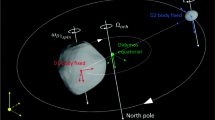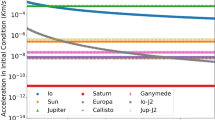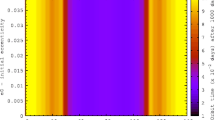Abstract
Recently, we have seen a series of space missions to the Moon and asteroids, whether for exploratory or scientific purposes, with possibilities of a lot of profitability in a sustainable way. Given this scenario, the Garatéa-L Mission (from the Brazilian original people language Tupi-Guarani, “Search for Life”) stands out, a genuinely Brazilian mission, whose main objective is to place a 6U brazilian cubeSat in orbit around the Moon, in 2024 or 2025, with the aim of carrying out experiments in astrobiology and studying the Aitken Basin, a basin located at the lunar south pole. In this context, the main goal of the present work is to study the orbits that meet the needs of the mission, obeying the necessary parameters of 300 km of periselene and 3000 km of aposelene. The system is formed by the Moon (the central body) and its gravitational coefficients, \(J_{2}\), \(J_{3}\) and \(C_{22}\), the Earth as the perturbing body and a particle (cubesat). As a result, we obtained a sample of orbits that meets the requirements of the mission, their lifetimes in the region of interest and the evolution of the semi-major axis and eccentricity for each value of the inclination analysed. The results showed that the largest number of orbits with the longest lifetime have inclinations of 60° and 65°, with a semi-major axis of 3460 km and an eccentricity of approximately 0.38, remaining in the mission’s region of interest for an approximate period of 180 days.
















Similar content being viewed by others
Data Availability
No datasets were generated or analysed during the current study.
Notes
Mercury Reference value: \(U\) (parameterized) = 4737.4 km .
Aitken Basin http://www.psrd.hawaii.edu/Dec96/IceonMoon.html.
References
Bridenstine, J.: Artemis plan - nasa’s lunar exploration program overview (2020). https://www.nasa.gov/sites/default/files/atoms/files/artemis_plan-20200921.pdf
Carvalho, J., Moraes, R., Prado, A.: Some orbital characteristics of lunar artificial satellites. Celest. Mech. Dyn. Astron. 108, 371–388 (2010). https://doi.org/10.1007/s10569-010-9310-6
Carvalho, J.P.S., Moraes, R.V., Prado, A.F.B.A.: Planetary satellite orbiters: Aplication for de moon. Math. Probl. Eng. 2011 (2011). https://doi.org/10.1155/2011/187478
Carvalho, J., Elipe, A., Moraes, R., et al.: Low-altitude, near-polar and near-circular orbits around Europa. Adv. Space Res. 49 (2012). https://doi.org/10.1016/j.asr.2011.11.036
Center UAS: Iau - wgccre (2020). https://astrogeology.usgs.gov/groups/IAU-WGCCRE
Chambers, J.: A hybrid symplectic integrator that permits close encounters between massive bodies. Mon. Not. R. Astron. Soc. 304, 793–799 (1999)
Cinelli, M., Lei, H., Ortore, E., et al.: Probe lifetime around natural satellites with obliquity. Astrodynamics 6(4), 429–439 (2022). https://doi.org/10.1007/s42064-022-0145-1
Ferreira, L., Sfair, R., Prado, A.: Lifetime and dynamics of natural orbits around Titan. Symmetry 14 (2022). https://doi.org/10.3390/sym14061243
Fonseca, L.: Garatéa-l - a scientific, technological and educational journey that aims to take Brazil to the moon in 2023 (2023). https://institutogaratea.com
Gomes, V.M., Domingos, R.C.: Studying the lifetime of orbits around moons in elliptic motion. Comput. Appl. Math. 35, 653–661 (2016). https://doi.org/10.1007/s40314-015-0258-8
Gonçalves, L.D., Rocco, E.M., Moraes, R.V.: Analysis of the influence of orbital disturbances applied to an artificial lunar satellite. J. Phys. Conf. Ser. 641 (2015). https://doi.org/10.1088/1742-6596/641/1/012028
Gupta, S., Sharma, R.: Effect of altitude, right ascension of ascending node and inclination on lifetime of circular lunar orbits. Int. J. Astron. Astrophys. 1, 155–163 (2011). https://doi.org/10.4236/ijaa.2011.13020
Kopal, Z., Carder, R.W.: Selenographic coordinates. Astrophys. Space Sci. Libr. 50, 61–71 (1974). https://doi.org/10.1007/978-94-010-2133-3
Launius, R., Conway, E., Johnston, A., et al.: Spaceflight: the development of science, surveillance, and commerce in space. In: Proceedings of the IEEE 100 (Special Centennial Issue), pp. 1785–1818. (2012). https://doi.org/10.1109/JPROC.2012.2187143
Liu, X., Baoyin, H., Ma, X.: Extension of the critical inclination. Astrophys. Space Sci. (2011). https://doi.org/10.1007/s10509-011-0685-y
Melo, C., Winter, O.C.: Alternative paths to Earth-moon transfer. Math. Probl. Eng. 2006 (2006). https://doi.org/10.1155/MPE/2006/34317
Meyer, K.W., Buglia, J.J., Desai, P.N.: Lifetimes of lunar satellite orbits. NASA Technical Paper 3394 (1994)
National Aeronautics and Space Administration: Lunar orbiter I (1967). https://ntrs.nasa.gov/api/citations/19670026411/downloads/19670026411.pdf
Paskowitz, M., Scheeres, D.: Design of science orbits about planetary satellites: Application to Europa. J. Guid. Control Dyn. 29(5) (2006). https://doi.org/10.2514/1.19464
Pickrell, J.: These six countries are about to go to the moon — here’s why (2022). https://www.nature.com/articles/d41586-022-01252-7
Pieters, C.M., Tompkins, S., Head, J.W., et al.: Mineralogy of the mafic anomaly in the south pole-Aitken basin: implications for excavation of the lunar mantle. Geophys. Res. Lett. 24, 1903–1906 (1997). https://doi.org/10.1029/97GL01718
Ramanan, R.V., Adimurth, V.: An analysis of near-circular lunar map** orbits. J. Earth Syst. 114(6), 619–626 (2005)
Robinson, K.L., Taylor, G.J.: Heterogeneous distribution of water in the moon. Nat. Geosci. 7, 401–408 (2014). https://doi.org/10.1038/ngeo2173
Technology CI: Jet propulsion laboratory (2020). https://ssd.jpl.nasa.gov/horizons.cgi
Tzirti, S., Tsiganis, K., Varvoglis, H.: Effect of 3rd-degree gravity harmonics and Earth perturbations on lunar artificial satellite orbits. Celest. Mech. Dyn. Astron. (2010). https://doi.org/10.1007/s10569-010-9313-3
Wang, Q., Liu, J.: A chang’e-4 mission concept and vision of future Chinese lunar exploration activities. Acta Astronaut. 127, 678–683 (2016). https://doi.org/10.1155/2009/159287
Winter, O., Vieira Neto, E.: Distant stable direct orbits around the moon. Astron. Astrophys. 393, 661–671 (2002). https://doi.org/10.1051/0004-6361:20021080
Xavier, J., Prado, A., Winter, S., et al.: Map** long-term natural orbits about titania, a satellite of Uranus. Symmetry 14, Article ID 667 (2022). https://doi.org/10.3390/sym14040667
Acknowledgements
SMGW thanks Conselho Nacional de Desenvolvimento Científico e Tecnológico - CNPq (Proc. 313043/2020-5), Fundação de Amparo a Pesquisa do Estado de São Paulo - FAPESP (Proc. 2016/24561-0), and Coordenação de Aperfeiçoamento de Pessoal de Nível Superior - CAPES for the financial support.
Author information
Authors and Affiliations
Contributions
The research was developed jointly as part of the corresponding author’s (GASB) doctoral thesis and SMGW was a supervisor. All figures and simulations were produced by GASB and the literature review was carried out by SMGW. The development of the programming was carried out by the two authors (GASB and SMGW). All authors reviewed the manuscript.
Corresponding author
Ethics declarations
Competing interests
The authors declare no competing interests.
Additional information
Publisher’s Note
Springer Nature remains neutral with regard to jurisdictional claims in published maps and institutional affiliations.
Rights and permissions
Springer Nature or its licensor (e.g. a society or other partner) holds exclusive rights to this article under a publishing agreement with the author(s) or other rightsholder(s); author self-archiving of the accepted manuscript version of this article is solely governed by the terms of such publishing agreement and applicable law.
About this article
Cite this article
Boaventura, G.A.S., Winter, S.M.G. Analysing orbits around the Moon for the Garatéa-L Mission. Astrophys Space Sci 369, 30 (2024). https://doi.org/10.1007/s10509-024-04297-4
Received:
Accepted:
Published:
DOI: https://doi.org/10.1007/s10509-024-04297-4




